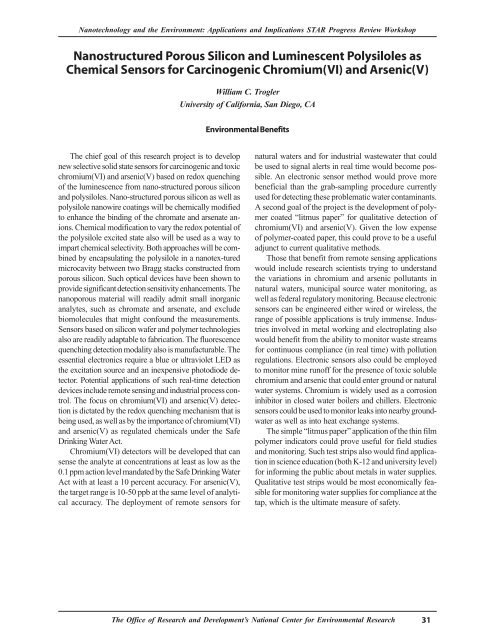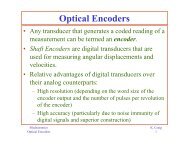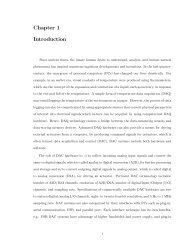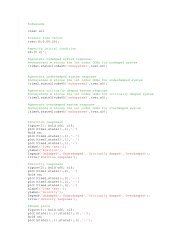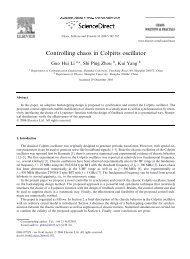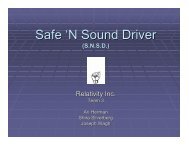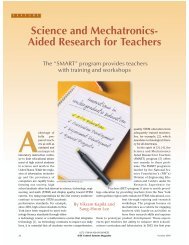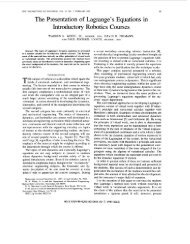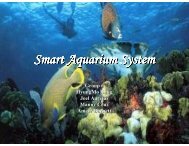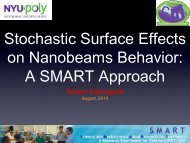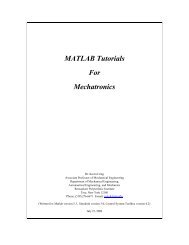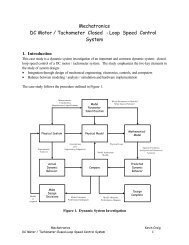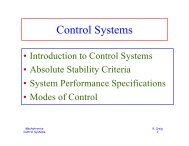EPA Nanotechnology and the Environment ... - Mechatronics
EPA Nanotechnology and the Environment ... - Mechatronics
EPA Nanotechnology and the Environment ... - Mechatronics
You also want an ePaper? Increase the reach of your titles
YUMPU automatically turns print PDFs into web optimized ePapers that Google loves.
<strong>Nanotechnology</strong> <strong>and</strong> <strong>the</strong> <strong>Environment</strong>: Applications <strong>and</strong> Implications STAR Progress Review Workshop<br />
Nanostructured Porous Silicon <strong>and</strong> Luminescent Polysiloles as<br />
Chemical Sensors for Carcinogenic Chromium(VI) <strong>and</strong> Arsenic(V)<br />
William C. Trogler<br />
University of California, San Diego, CA<br />
<strong>Environment</strong>al Benefits<br />
The chief goal of this research project is to develop<br />
new selective solid state sensors for carcinogenic <strong>and</strong> toxic<br />
chromium(VI) <strong>and</strong> arsenic(V) based on redox quenching<br />
of <strong>the</strong> luminescence from nano-structured porous silicon<br />
<strong>and</strong> polysiloles. Nano-structured porous silicon as well as<br />
polysilole nanowire coatings will be chemically modified<br />
to enhance <strong>the</strong> binding of <strong>the</strong> chromate <strong>and</strong> arsenate anions.<br />
Chemical modification to vary <strong>the</strong> redox potential of<br />
<strong>the</strong> polysilole excited state also will be used as a way to<br />
impart chemical selectivity. Both approaches will be combined<br />
by encapsulating <strong>the</strong> polysilole in a nanotex-tured<br />
microcavity between two Bragg stacks constructed from<br />
porous silicon. Such optical devices have been shown to<br />
provide significant detection sensitivity enhancements. The<br />
nanoporous material will readily admit small inorganic<br />
analytes, such as chromate <strong>and</strong> arsenate, <strong>and</strong> exclude<br />
biomolecules that might confound <strong>the</strong> measurements.<br />
Sensors based on silicon wafer <strong>and</strong> polymer technologies<br />
also are readily adaptable to fabrication. The fluorescence<br />
quenching detection modality also is manufacturable. The<br />
essential electronics require a blue or ultraviolet LED as<br />
<strong>the</strong> excitation source <strong>and</strong> an inexpensive photodiode detector.<br />
Potential applications of such real-time detection<br />
devices include remote sensing <strong>and</strong> industrial process control.<br />
The focus on chromium(VI) <strong>and</strong> arsenic(V) detection<br />
is dictated by <strong>the</strong> redox quenching mechanism that is<br />
being used, as well as by <strong>the</strong> importance of chromium(VI)<br />
<strong>and</strong> arsenic(V) as regulated chemicals under <strong>the</strong> Safe<br />
Drinking Water Act.<br />
Chromium(VI) detectors will be developed that can<br />
sense <strong>the</strong> analyte at concentrations at least as low as <strong>the</strong><br />
0.1 ppm action level m<strong>and</strong>ated by <strong>the</strong> Safe Drinking Water<br />
Act with at least a 10 percent accuracy. For arsenic(V),<br />
<strong>the</strong> target range is 10-50 ppb at <strong>the</strong> same level of analytical<br />
accuracy. The deployment of remote sensors for<br />
natural waters <strong>and</strong> for industrial wastewater that could<br />
be used to signal alerts in real time would become possible.<br />
An electronic sensor method would prove more<br />
beneficial than <strong>the</strong> grab-sampling procedure currently<br />
used for detecting <strong>the</strong>se problematic water contaminants.<br />
A second goal of <strong>the</strong> project is <strong>the</strong> development of polymer<br />
coated “litmus paper” for qualitative detection of<br />
chromium(VI) <strong>and</strong> arsenic(V). Given <strong>the</strong> low expense<br />
of polymer-coated paper, this could prove to be a useful<br />
adjunct to current qualitative methods.<br />
Those that benefit from remote sensing applications<br />
would include research scientists trying to underst<strong>and</strong><br />
<strong>the</strong> variations in chromium <strong>and</strong> arsenic pollutants in<br />
natural waters, municipal source water monitoring, as<br />
well as federal regulatory monitoring. Because electronic<br />
sensors can be engineered ei<strong>the</strong>r wired or wireless, <strong>the</strong><br />
range of possible applications is truly immense. Industries<br />
involved in metal working <strong>and</strong> electroplating also<br />
would benefit from <strong>the</strong> ability to monitor waste streams<br />
for continuous compliance (in real time) with pollution<br />
regulations. Electronic sensors also could be employed<br />
to monitor mine runoff for <strong>the</strong> presence of toxic soluble<br />
chromium <strong>and</strong> arsenic that could enter ground or natural<br />
water systems. Chromium is widely used as a corrosion<br />
inhibitor in closed water boilers <strong>and</strong> chillers. Electronic<br />
sensors could be used to monitor leaks into nearby groundwater<br />
as well as into heat exchange systems.<br />
The simple “litmus paper” application of <strong>the</strong> thin film<br />
polymer indicators could prove useful for field studies<br />
<strong>and</strong> monitoring. Such test strips also would find application<br />
in science education (both K-12 <strong>and</strong> university level)<br />
for informing <strong>the</strong> public about metals in water supplies.<br />
Qualitative test strips would be most economically feasible<br />
for monitoring water supplies for compliance at <strong>the</strong><br />
tap, which is <strong>the</strong> ultimate measure of safety.<br />
The Office of Research <strong>and</strong> Development’s National Center for <strong>Environment</strong>al Research 31


